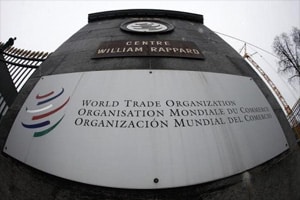As India negotiates hard to secure a special safeguard mechanism (SSM) at the World Trade Organization (WTO) to protect farmers from a sudden spurt in imports, many analysts have questioned the strategy.
They argue that since the bound rates of several agricultural commodities are much higher than the applied tariffs for them, there is enough space for India to safeguard its interests and so, there wasn’t any crying need for an extra armour.
While the bound rates — the highest level of import duty a country can impose under the WTO rules — for India have been in the range of 25-300% for most farm items, the actual applied tariffs are mostly in the 0-80% range.
So the analysts argue that when a much wider — and mostly underutilised —window is already available to raise the duties and protect farmers’ interests, the government should have had a greater focus on more pressing issues at the recently-concluded Nairobi ministerial instead of trying to seek something that “won’t bring in any special advantage” at this stage.
“Our emphasis on the SSM and even a permanent solution for public stock-holding issues at the WTO was out of place,” said Anwarul Hoda, chair professor, trade policy and WTO research programme at ICRIER. “Our priority should have been to bring the developed countries, especially the US, back to the negotiating table and ask them to commit more on cutting down on the massive trading-distorting farm subsidies they are offering,” he added.
The US and the EU provide massive farm subsidies (at the production level), in the range of 57-215% of the output value of several agricultural commodities. This makes their farm products highly competitive vis-à-vis those of developing nations in the export market.
However, countering the view, a senior commerce ministry official said: “The US has already conveyed that trimming the farm subsidies is a red line for them. Some call it an ‘obstructionist’ attitude by the US, but it’s not willing to budge on such a position.”
“Every country can have a wish-list and they are entitled to negotiate on that. But since everything has to be done through consensus at the WTO, you can’t force another country to sit on the negotiating table and accept your terms of trade,” he said. Still, India has been asking the developed world to commit more on farm subsidy cut, and even the Nairobi declaration acknowledged the need for it, he added.
Abhijit Das, head of the Centre For WTO Studies, argued that the country needs an SSM because, while in many commodities there is a huge difference between the bound and applied tariff rates, in some cases, the gap doesn’t even exist. For instance, the bound rates and the applied rates are the same in apples and rice(milled) — 50% and 70%, respectively. This means the country doesn’t have a solid protection mechanism to offer to protect farmers from a sudden or irrational surge in such imports. Even in the case of dairy and chicken products or even olive oil the gap between the bound rates and actual rate is very minimal, he added.
The commerce ministry official also argued that even the developed countries, which are also entitled to have bound rates fixed for farm commodities, are enjoying the privilege of a mechanism called special safeguard duties (SSG). “If they can enjoy such a mechanism, why should the developing countries be deprived of it to benefit from in exceptional situations?” he asked.



